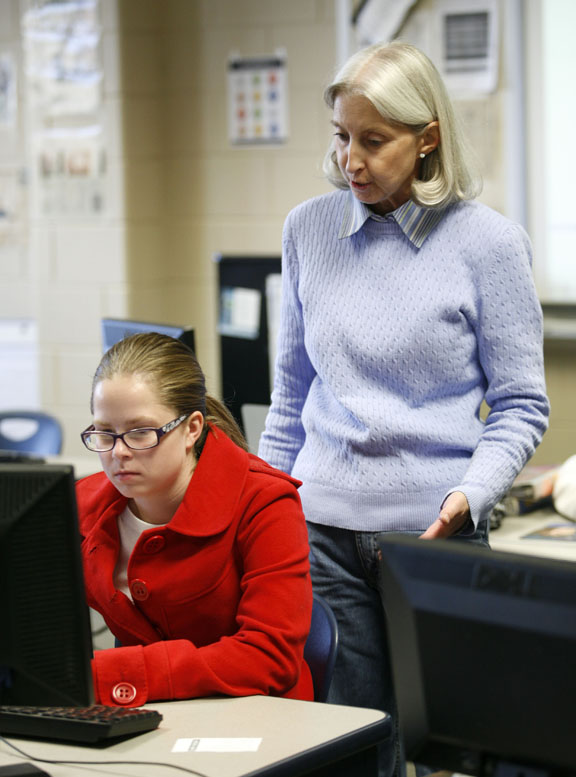
Business teacher Virgena Rhodes helps junior Tabitha Strange research careers as part of her ILP at Knox Central High School (Knox County) Oct. 29, 2010. Strange plans on working as a gastroenterologist. Photo by Amy Wallot
By Matthew Tungate
matthew.tungate@education.ky.gov
Kentucky’s plan to increase college and career readiness relies heavily on a tool already familiar to teachers and students in the state – the Individual Learning Plan (ILP).
Now in its fifth year, the ILP is a Web-enabled college- and career-planning tool that allows students in grades 6-12 to begin thinking about life after high school, according to Sharon Johnston, the ILP program consultant for the Kentucky Department of Education (KDE). The centerpiece of the ILP is the career matchmaker, which gives students clusters of jobs that match their interests based on their answers to 116 questions, she said.
“It’s the first time, possibly, that they’ve really been asked to say, ‘What do I like to do? What am I good at? And, knowing that, ‘What kind of jobs may I be good at?’” Johnston said. “The next step is, ‘What kind of courses do I need to take in high school to be competitive in that job when I leave high school. What colleges offer that program?’”
The ILP allows students to look at various college programs and their costs, as well as careers and their expected salaries in Kentucky, among many other things, she said.
“It’s a very comprehensive tool,” Johnston said.
Kentucky’s plan for improving college and career readiness for students incorporates the ILP and expands on it. KDE is developing an Advising Toolkit, including the ILP, that will assist schools in developing a comprehensive advising program for middle and high school students. The toolkit will focus on academic, career, financial and personal/social development. Individual students will be advised based on career pathways identified in the student’s ILP.
KDE will be releasing the toolkit in the spring, with Kentucky Virtual Schools offering online professional development for teachers to promote the use of the ILP beginning in January, Johnston said.
“The idea is that if they do not currently have a comprehensive advising program, they will be able to build one using the resources that will be in the toolkit,” she said.
Eighty-five percent of students statewide have completed their ILPs, up from 15 percent the first year, Johnston said. Until now, schools have focused on getting students to complete their ILPs. Now, Johnston said, the department wants schools to engage students in using the ILP throughout the year across content areas.
When students have identified their goals, they are more engaged in learning, ask questions and may be willing to do extra work because they can see benefit of what they are learning, she said.
“‘Wow, I’m excited about this because I understand that it’s not just a class that I need to pass, but I’m learning something for me and my future,’” they might say, Johnston said.
Johnston said suggestions on how to implement the ILP in the classroom can be found in the administrative view of the ILP. She also recommended a document from Ballard Memorial High School (Ballard County), which has 100 percent student completion of the ILP.
Renee McDermott, a business teacher at Ballard County Career and Technical Center, and Ballard Memorial counselor Lorry Beth Wilson work together to make sure students’ ILPs are complete.
McDermott said she created activities that are placed in a shared folder at her school.
“I also encourage our teachers to use the ILP in at least one lesson or more each semester,” she said. “The ILP will fit into any curriculum.”
Teachers can look at the careers and colleges students plan to go into so they can focus on those skills that the majority of the students need, McDermott said.
“You can also see what they plan to do so you are able to relate to them more. As teachers, the administrator of the ILP at your school also can see what classes the students are interested in,” she said. “Teachers can use the skills section to show students which skills will be needed in the workforce and help them to implement these into the classroom.”
Wilson said students work on their ILPs for two weeks at a time every eight weeks during the academic enrichment part of their day.
“The ILP is such a wonderful tool that all students can use in and out of their classrooms. The students see the importance of the ILP for their own personal use, and they want to complete their ILPs and keep them up-to-date,” she said. “Our teachers also help the students understand the importance of their ILPs. They use it in curriculum at least once a semester.”

Students in Gina Martin’s class research careers as part of their ILPs at Knox Central High School (Knox County) Oct. 29, 2010. Photo by Amy Wallot
Wilson said teachers and administrators need to be trained to use the ILP to its fullest potential.
“If the school district has simply added one more thing to a teacher’s already full platter, then the ILP is usually just pushed to the background and not used effectively,” she said. “Teachers and administrator need to realize that this is an asset to the teacher, student and classroom.”
Knox Central High School (Knox County) is working to improve its 47 percent ILP-completion rate by rotating adviser groups into the business labs, where the business and content teachers collaborate to work with students on their ILPs, according to Renee Adams, business department chair.
Adams said business classes at Knox Central High were ahead of the rest of the school in incorporating the ILP.
“From the beginning of ILP, our business teachers incorporated the process into career awareness and work readiness,” she said.
Using the ILP helps students think beyond the boundaries of the area that they live in, Adams said.
“They realize that there are opportunities that relate to their interest and abilities,” she said. “They realize the importance of the courses they are choosing in high school for their future occupations. They set long- and short-term goals, which give them a focus.”
MORE INFO …
Sharon Johnston, sharon.johnston@education.ky.gov, (502) 564-4772



Leave A Comment